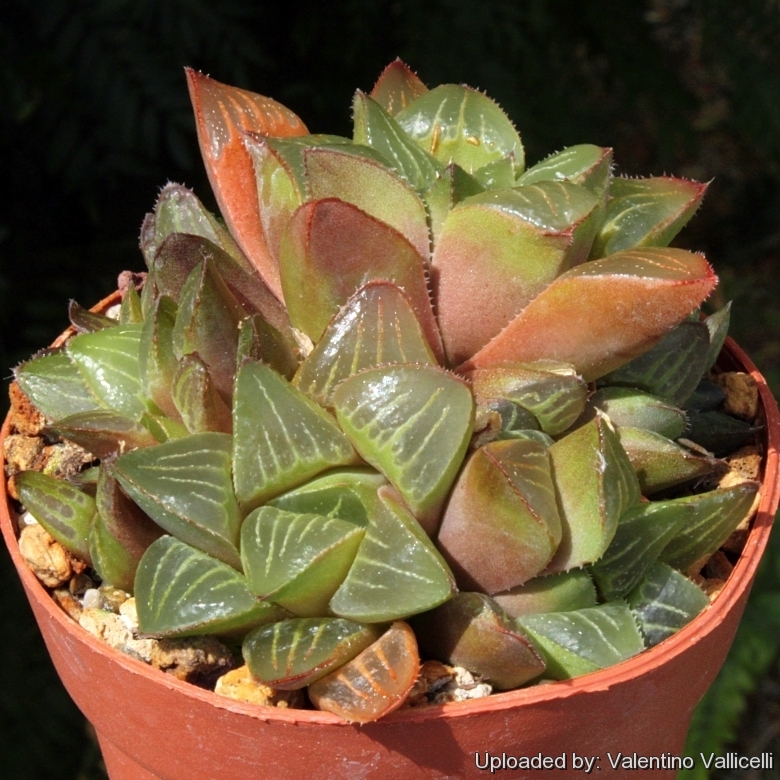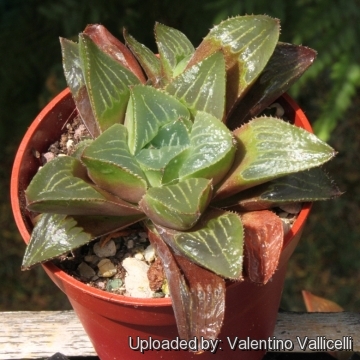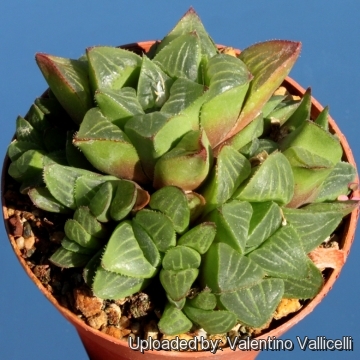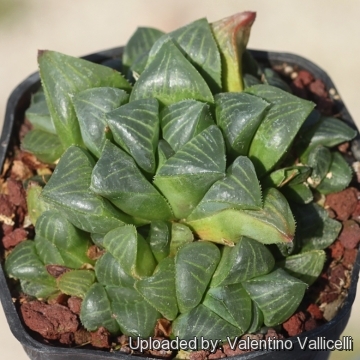
Haworthia mutica Photo by: Valentino Vallicelli
Origin and Habitat: South Africa (Western Cape: Overberg)
Habitat: Haworthia muticaSN|16744]]SN|16796]] grows almost buried in the ground on rocky shale ridges often in crevices. It shares its distribution area with Haworthia maraisiiSN|16986]]SN|16714]], Haworthia russouwii, Haworthia modestaSN|16714]]SN|16986]], Haworthia heidelbergensisSN|16796]]SN|16744]] var. minor and Gasteria carinataSN|17224]]SN|17224]]. In many other embedded plant forms, including Bulbine mesembryanthemoidesSN|22628]]SN|22628]] and many species of Opthalmophyllum and Lithops, light reaches internal chloroplasts in the buried leaf through windows of unpigmented cells on the exposed leaf tips. Small succulents resemble the soil, stones or dung of their habitats, or the shadows and woody stems of the shrubs that shelter them. Individuals that escape predation may be remarkably long-lived, up to 95 years in the case of Lithops plants.
Synonyms:
See all synonyms of Haworthia mutica
back
Accepted name in llifle Database:Haworthia mutica Haw.Saxifrag. Enum. 2: 55 1821. (Revis. Pl. Succ. 55)Synonymy: 4
Accepted name in llifle Database:Haworthia mutica var. nigra M.B.BayerHaworthia Revisited 126 (1999)Synonymy: 2
back
Description: Haworthia muticaSN|16750]]SN|16796]] is one of the retuse-leaved haworthias, with compact flattened rosettes of prominently windowed leaves. It is mainly a non-proliferous species that do not offsets or offsets slowly, but most of the plants in cultivation derives from very prolific clones and form soon dense clumps. It is a variable species sometimes difficult to distinguish from to Haworthia retusaSN|16708]]SN|16708]] and Haworthia pygmaeaSN|16796]]SN|16750]].
Leaves: Thick geometric, truncated and triangular at apex, glaucous grey-green or glossy dark green with a characteristic bluish-brown colouration, often developing purplish cloudiness and striped in subtle shades of green. The tips are transparent and act like windows, allowing sun to enter inside of the leaf for chlorophyll processing.
Flowers: Small, two-lipped, greenish-white with pale purplish veins.
Blooming season: Mainly in Summer but it may flowers in any favourable season.
Subspecies, varieties, forms and cultivars of plants belonging to the Haworthia mutica group
 Haworthia mutica Haw.: has compact flattened rosettes of retuse and prominently windowed leaves. Distribution: Western Cape.
Haworthia mutica Haw.: has compact flattened rosettes of retuse and prominently windowed leaves. Distribution: Western Cape. Haworthia otzenii G.G.Sm.: has green leaves with parallel light markings on tips, but plants in cultivation appear to be hybrids of Haworthia mirabils. Distribution: Napier, Western Cape.
Haworthia otzenii G.G.Sm.: has green leaves with parallel light markings on tips, but plants in cultivation appear to be hybrids of Haworthia mirabils. Distribution: Napier, Western Cape.
Bibliography: Major references and further lectures
1) Gordon D. Rowley “The illustrated encyclopedia of succulents” Crown Publishers, 01/Aug/1978
2) Urs Eggli “Illustrated Handbook of Succulent Plants: Monocotyledons” Springer, 2001
3) Charles L. Scott “The genus Haworthia (Liliaceae): a taxonomic revision” Aloe Books, 1985
4) Stuart Max Walters “The European Garden Flora: Pteridophyta, Gymbospermae, Angiospermae-Monocotyledons” Cambridge University Press, 1984
5) M. B. Bayer “The new Haworthia handbook” National Botanic Gardens of South Africa, 1982
6) John Pilbeam “Haworthia and Astroloba: A Collector's Guide” B. T. Batsford Limited, 1983
7)Bayer, M.B and van Jaarsveld, E. 2001.” Haworthia. in Illustrated Handbook of Succulent Plants: Monocotyledons.” Springer, Berlin.
8) Bruce Bayer “Haworthia revisited: a revision of the genus” Umdaus Press, 1999
 Haworthia mutica Photo by: Valentino Vallicelli
Haworthia mutica Photo by: Valentino Vallicelli Haworthia mutica Photo by: Valentino Vallicelli
Haworthia mutica Photo by: Valentino Vallicelli Haworthia mutica Photo by: Valentino Vallicelli
Haworthia mutica Photo by: Valentino VallicelliSend a photo of this plant.The gallery now contains thousands of pictures, however it is possible to do even more. We are, of course, seeking photos of species not yet shown in the gallery but not only that, we are also looking for better pictures than those already present.
Read More... Cultivation and Propagation: Haworthia muticaSN|16796]]SN|16796]] grows best in bright but indirect, or moderate light or redden nicely in full sun. It grows without any major problems in cultivation and is an ideal small indoor plant. Outdoors it suit in rockeries, but avoid frost.
Soil: They are slow growing and prefer a porous, well-draining soil.
Moisture: They need regular water, but don't let the soil be constantly moist or soggy and while not wanting to be excessively wet, they will be equally unhappy if the soil is kept dry for long periods.
Hardiness: They do best in warm dry climates. Frost Tolerance: -1.C° (or less for short periods).
Propagation: They should be propagated by seeds or vegetatively by leave cuttings or division of larger clumps.













